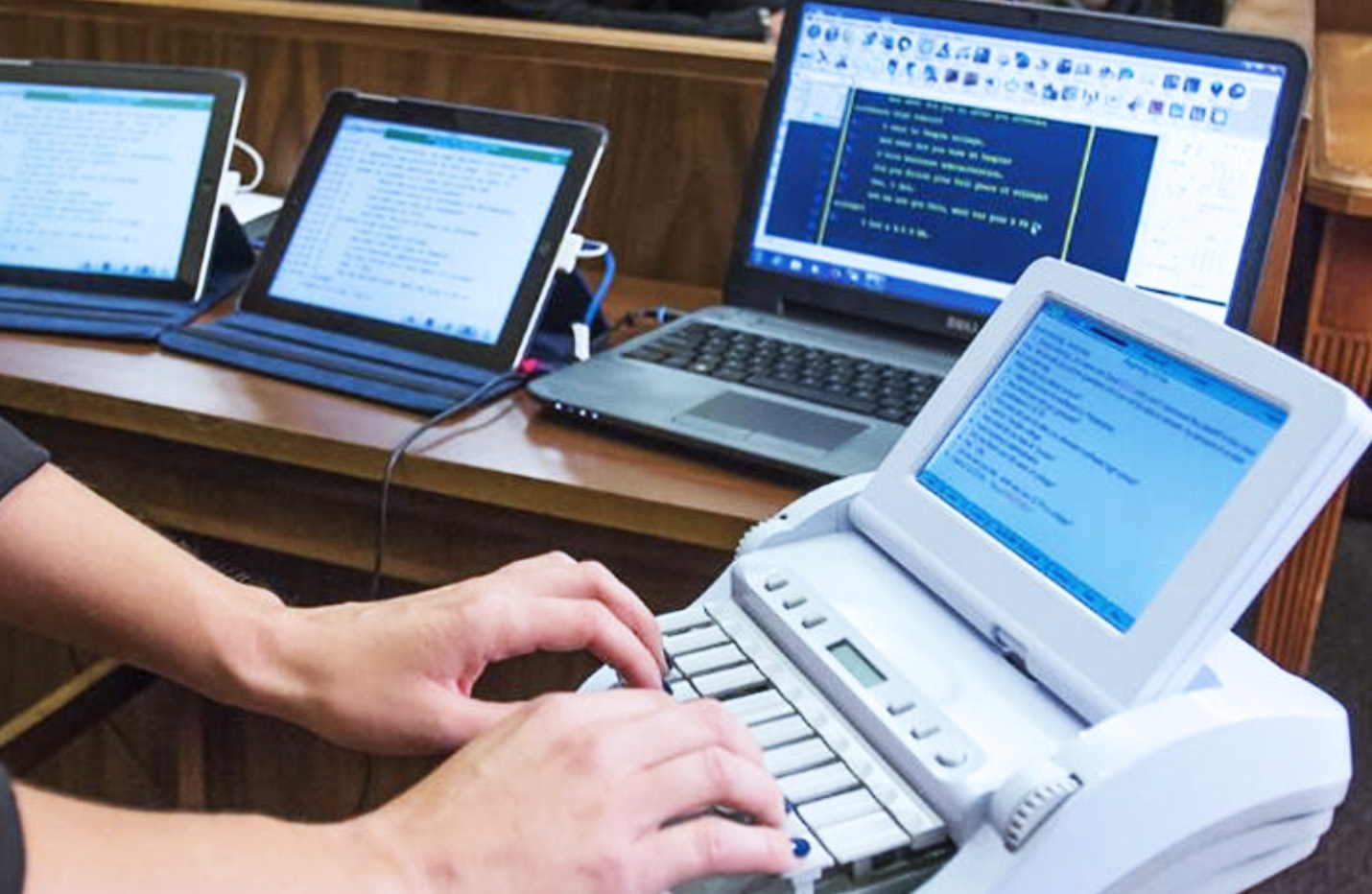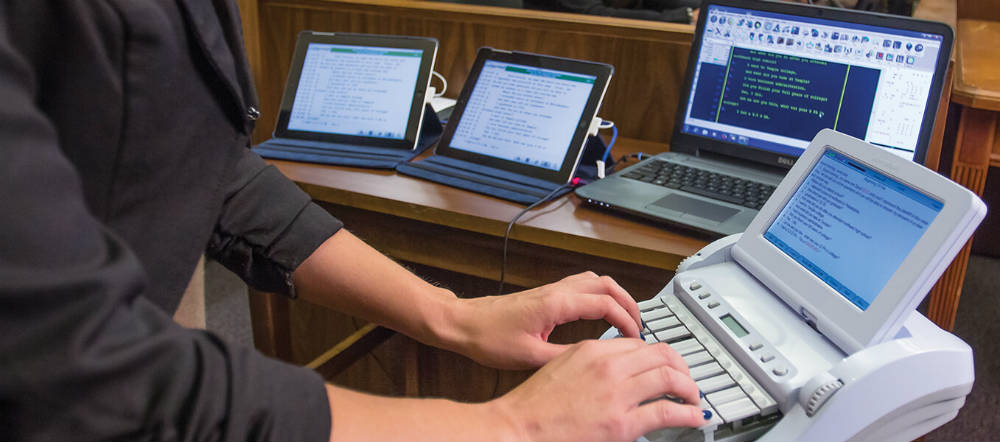Exactly How Court Reporting Functions: A Step-by-Step Guide to the Legal Process
Court reporting is a critical part of the lawful system. It entails an organized procedure that ensures exact paperwork of process. From prep work to the last distribution of records, each action is important. Understanding just how stenotype reporter run offers insight right into the honesty of legal records. The nuances of their work can exceptionally affect lawful end results, motivating questions about the modern technologies and approaches they use. What are the particular methods that specify this profession?
The Duty of Court Reporters in the Legal System
Court reporters play a vital duty in the lawful system by giving exact and dependable transcripts of court procedures. Their job warranties that every spoken word during depositions, trials, and hearings is documented, which is crucial for maintaining an official document of occasions. This transcription is essential for allures, as it allows greater courts to evaluate the process and determine if any type of mistakes were made throughout the test.
In addition, court press reporters assist in protecting the honesty of the lawful process by producing verbatim records that can be referred to by legal representatives, judges, and other celebrations involved in a situation. They often utilize customized equipment and software to capture discussion with accuracy. Beyond the court room, their records can work as vital historic papers, using understanding right into judicial procedures and the legal system's functioning. Inevitably, stenotype reporter add significantly to transparency and accountability in lawful issues.
Preparing for a Court Reporting Session
Prep work is vital for an effective court reporting session, as it guarantees the precision and effectiveness of the transcription procedure. Stenotype reporter begin by assessing case materials, consisting of pleadings and witness lists, to acquaint themselves with the terminology and context. They likewise make sure that they have the essential devices, such as steno devices, note pads, and back-up gadgets, on-line.
Before the session, interaction with legal teams is crucial. Reporters frequently clarify any kind of particular requests pertaining to format or liked terminology. Additionally, they may organize to satisfy with witnesses or attorneys to go over the proceedings and verify the schedule. Showing up early to set up the equipment allows for repairing possible technical issues. Generally, detailed prep work not just enhances the reporter's confidence but additionally adds substantially to creating a clear and exact record of the legal procedures.

Catching the Record: Techniques and Equipment
Utilizing innovative techniques and trusted equipment, court press reporters meticulously record the spoken word during lawful process. They use stenography, a method including a specialized maker that permits them to kind multiple noises concurrently, consequently transcribing discussion in genuine time. This device, referred to as a steno key-board, is geared up with keys that represent syllables and words, enabling swift and exact input.
Along with stenography, court reporters may make use of audio recording gadgets as additional devices. These gadgets serve as back-ups, making sure that no vital information is lost during proceedings. Additionally, some press reporters incorporate software that boosts their transcription effectiveness, offering attributes such as voice recognition and automated format.
Proper positioning and focus are vital; press reporters should maintain attention on all audio speakers, catching nuances and inflections that contribute to the document. With a combination of ability and technology, stenotype reporter support the honesty of the legal process by ensuring a complete and accurate document of events.
Recording the Process
Recording the proceedings calls for court reporters to convert talked dialogue right into composed text with outstanding accuracy and rate. This procedure commonly occurs right away after the recording has actually been recorded, utilizing specialized software application that enables seamless transcription. Stenotype reporter have to pay attention diligently to the audio, guaranteeing that every inflection, word, and pause is properly represented in the records.
They typically rely on shorthand systems, individual transcription abilities, and progressed technology to promote this task. The setting in which they work can be busy and often chaotic, as legal process typically entail multiple speakers and technical jargon. Court press reporters need to also maintain focus to record subtleties in tone and context that might be crucial for the legal record. Inevitably, the precision of the transcription is critical, as it serves as a certification for future recommendation in lawful procedures.
Reviewing and Modifying the Records
The procedure of reviewing and editing and enhancing the records is important for ensuring precision in court reporting. Court reporters often work together with lawyers to clarify any kind of obscurities and confirm the accuracy of the taped declarations. This collaboration is essential for maintaining the stability of the lawful document.
Significance of Accuracy
Precision works as the keystone of efficient court reporting, as even minor mistakes can considerably change the significance of legal procedures. The reviewing and editing procedure is critical in guaranteeing that transcripts reflect the talked word with integrity. Court press reporters diligently validate names, technological terms, and lawful jargon to keep accuracy. This focus to detail aids prevent misunderstandings that might influence case end results. In addition, accuracy cultivates trust fund among lawyers, customers, and the court, strengthening the integrity of the judicial system. Mistakes can lead to disagreements or charms, making it essential for reporters to improve their work extensively. Ultimately, over here the search of accuracy not only enhances the dependability of the records however likewise maintains the standards of the legal profession.
Partnership With Attorneys
Collaboration between stenotype reporter and lawyers is crucial throughout the examining and modifying stage of records manufacturing. This process guarantees that the final document accurately mirrors the spoken word and follows legal requirements. Attorneys typically examine records for particular terms, context, and any kind of prospective errors that can influence the situation. Court press reporters depend on attorneys' expertise to clear up ambiguous areas or highlight important statements. Effective communication is vital; attorneys might provide feedback or request adjustments, which court press reporters have to resolve immediately. This collaboration not only enhances the top quality of the records yet also adds to a smoother legal process. Eventually, joint initiatives lead to a specific and dependable document, vital for lawful process and future recommendations.
Delivering the Last Transcript to Clients
Upon completion of the transcription procedure, court press reporters thoroughly prepare the last record for distribution to their customers. This last transcript undertakes detailed checking Learn More Here to assure precision, as any type of mistakes could significantly influence legal proceedings. Court press reporters format the document according to the specific requirements set forth by the clients or lawful firms, consisting of pagination, indexing, and any type of needed exhibitions.

Court press reporters might offer a cover letter summing up vital information and providing additional support if needed. This thorough strategy assurances that customers receive a sleek, precise, and quickly navigable records, necessary for their legal requirements.
Often Asked Inquiries
What Certifications Are Needed to Come To Be a Court Reporter?
To end up being a stenotype reporter, people typically need a senior high school diploma, conclusion of a court reporting program, and accreditation or licensure, depending on state needs. durham court reporting. Efficiency in shorthand and innovation is also vital for success
Just how Lengthy Does It Take to Complete Court Reporting Training?
Generally, finishing court reporting training takes between 18 months to 4 years, relying on the program's intensity, the trainee's speed, and the certain needs of the jurisdiction in which they want to exercise.

What Is the Typical Salary of a Stenotype Reporter?
The average salary of a stenotype reporter varies by place and experience, typically ranging from $45,000 to $100,000 each year (durham court reporting). Aspects such as field of expertise and demand can significantly affect their revenues in different areas
Are Court Reporters Required to Have Accreditation?
Court press reporters are normally needed to obtain accreditation, which assures they possess the essential skills and expertise for precise transcription. Qualification needs can vary by state or territory, reflecting expert criteria within the legal area.
Can Court Reporters Work Remotely or Freelance?
Stenotype reporter can work remotely or freelance, giving flexibility in their occupation. Several utilize technology to transcribe process from various places, permitting diverse chances in the lawful field while keeping a work-life balance.
Court reporters play a vital duty in the legal system by offering precise and trustworthy transcripts of court procedures. Furthermore, court reporters help in preserving the stability of the legal procedure by developing verbatim documents that look at this now can be referred to by lawyers, judges, and various other events included in an instance. Utilizing advanced techniques and reputable tools, court press reporters diligently record the talked word throughout lawful procedures. Court reporters must also preserve focus to capture subtleties in tone and context that may be crucial for the lawful record. To come to be a court press reporter, people generally need a high school diploma, completion of a court reporting program, and certification or licensure, depending on state needs.